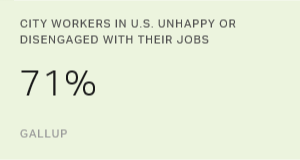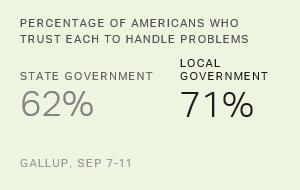Falling revenues, major demographic shifts and rising citizen demands have become the new normal for city governments across the U.S. If city halls want to deliver on their promises to provide high-quality services, they'll need to find better ways to make government run more effectively.
One big way to do that is to view every city employee as a key contributor to their success.
Every single one.
Local elected officials who treat their public workforce as anything less than their No. 1 resource are missing the boat. City employees are usually the largest line item in the budget. They know firsthand the public's concerns because they're on the front lines, and often they exhibit the exact depth of commitment to the community we'd want and expect from such service providers.
The problem is, only 29% of full-time local -- as well as state -- government workers are engaged at work, according to Gallup's 2016 "State of Local and State Government Workers' Engagement in the U.S." report. This mirrors engagement for government workers at the federal level. (Among the U.S. workforce overall, 33% of employees are currently engaged in their jobs.) As a result, 71% of full-time state and local government workers are unhappy or disengaged with their jobs, and this creates a missed opportunity for city administrators to drive innovation and move their communities forward.
Gallup also finds that disengaged employees may meet their job expectations but do not expend discretionary energy or feel passion for their work.
Gallup estimates that a lack of engagement among government employees costs U.S. taxpayers an estimated $18 billion per year. That's a high price tag for losing out on this discretionary energy. On the positive side, big productivity gains are possible when local governments fully and creatively deploy that same discretionary energy.
Many cities attempt to measure and increase their employees' engagement and commitment to doing good work through regular employee surveys, often juxtaposed with equally important resident surveys to understand key issues of public concern. Gathering such information about what motivates and activates civil servants isn't just cost-effective -- it's also smart.
Common drivers of high employee engagement include frequently praising and recognizing employees' accomplishments, offering personal and career development opportunities, incorporating employees' ideas, and connecting workers' tasks to overall city goals.
Many cities are succeeding on these fronts. For example, the City of San Antonio offers employees a series of training and mentoring programs, and recently created a dedicated "employee engagement coordinator" position to keep these values front and center.
As partisan gridlock continues to stymie progress in our nation's capital, Americans will look to their local governments to solve our country's most pressing problems. This will require cities to find new ways to create high performance. City government leaders' first step should be to adopt strengths-based practices to help employees identify and develop their innate talents and unlock their full potential.
While this solution isn't necessarily expensive, it will entail some investment. The key requirement, though, will be to exercise the courage and the vision to intentionally create a highly engaged culture in every corner of city government.
Steven Bosacker is the Director of Public Sector Innovation at Living Cities.
Justin Bibb is a Senior Adviser at Gallup.
This blog post is part of a special initiative to highlight the Equipt to Innovate framework, a national initiative led by Living Cities and Governing to equip cities with an integrated, collaborative framework of seven essential elements that define high-performance government and empower innovation.




